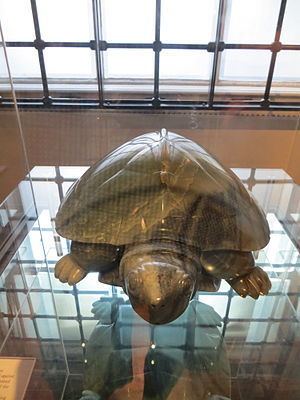Material Carved jade Created 17th century AD Present location British Museum | Weight 41 kg Registration ME OA 1830.6-12.1 | |
 | ||
Size 20 cm high, 48.5 cm long and 32 cm wide Similar Sphinx of Taharqo, Hoa Hakananai'a, Lewis chessmen | ||
The Jade Terrapin from Allahabad is a large sculpture of a terrapin carved from a single piece of jade. Dating from the early 17th Century when most of India was ruled by the Mughal dynasty, this luxurious and unique artefect was found in Allahabad in the early nineteenth century.
Contents
Description
This massive object of precious stone was carved from one large piece of jade in the 17th century for the court of the Mughal Emperor Jahangir. The terrapin has been very realistically portrayed, so much so that scientists have proposed that it is modelled on a female of the Kachuga dhongoka species of turtle. Jahangir established a royal court at Allahabad between 1605-1627. The terrapin was probably made during this period as a decorative ornament for one of the landscaped pools in the palace gardens.
Discovery and ownership
The jade sculpture was accidentally found at the bottom of a well during engineering excavations in Allahabad in 1803. Its artistic skill and value was immediately recognised by its excavators and the object was soon after shipped to England by Lieutenant General Alexander Kyd of the Bengal Engineers. A relative of the Kyd family, Lt Thomas Wilkinson, subsequently bequeathed it to the British Museum in 1830.
